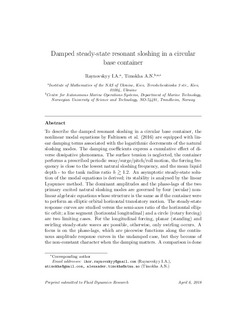| dc.description.abstract | To describe the damped resonant sloshing in a circular base container, the nonlinear modal equations by Faltinsen et al (2016 J. Fluid Mech. 804 608–45) are equipped with linear damping terms associated with the logarithmic decrements of the natural sloshing modes. The damping coefficients express a cumulative effect of diverse dissipative phenomena. The surface tension is neglected, the container performs a prescribed periodic sway/surge/pitch/roll motion, the forcing frequency is close to the lowest natural sloshing frequency, and the mean liquid depth—to the tank radius ratio h gsim 1.2. An asymptotic steady-state solution of the modal equations is derived; its stability is analysed by the linear Lyapunov method. The dominant amplitudes and the phase-lags of the two primary excited natural sloshing modes are governed by four (secular) nonlinear algebraic equations whose structure is the same as if the container were to perform an elliptic orbital horizontal translatory motion. The steady-state response curves are studied versus the semi-axes ratio of the horizontal elliptic orbit; a line segment (horizontal longitudinal) and a circle (rotary forcing) are two limiting cases. For the longitudinal forcing, planar (standing) and swirling steady-state waves are possible, otherwise, only swirling occurs. A focus is on the phase-lags, which are piecewise functions along the continuous amplitude response curves in the undamped case, but they become of the non-constant character when the damping matters. A comparison is done with measurements of the phase-lag by Royon-Lebeaud et al (2007 J. Fluid Mech. 577 467–94) (longitudinal forcing) to show that, if the damping rates are associated with the boundary layer at the wetted tank surface and the bulk viscosity, a satisfactory agreement is established with lower wave amplitudes but the cumulative damping effect must be larger to fit the experiments with increasing amplitudes. For elliptic forcing, stable swirling can be co- or counter-directed with the forcing direction. However, damping makes the counter-directed swirling impossible as the elliptic forcing orbit tends to a circle. | nb_NO |
